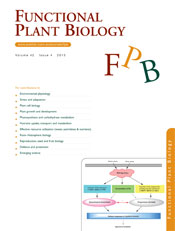
Functional Plant Biology
Volume 42 Number 4 2015
FP14189Hydrogen peroxide promotes programmed cell death and salicylic acid accumulation during the induced production of sesquiterpenes in cultured cell suspensions of Aquilaria sinensis
We investigated the formation of agarwood, a substance believed to have interesting medicinal properties and that is produced only by certain plants when they are responding to an injury or infection. We evaluated the effects of hydrogen peroxide on cells of the plant Aquilaria sinensis; as we expected, the plant cells responded to this damaging chemical with specific changes in gene expression and the production of compounds known to be linked with toxicity and programmed cell death. Our results indicate that exposure to a reactive oxygen species, such as hydrogen peroxide, produces multiple cellular responses that culminate in an effective defensive reaction on the part of the plant (i.e. production of agarwood).
FP14166Sufficient leaf transpiration and nonstructural carbohydrates are beneficial for high-temperature tolerance in three rice (Oryza sativa) cultivars and two nitrogen treatments
Extreme high temperature can threaten rice (Oryza sativa L.) production by decreasing its seed setting percentage; however, sufficient nitrogen can alleviate this detrimental effect. Heat-tolerant cultivars show high leaf transpiration and nonstructural carbohydrates, and sufficient nitrogen can improve them. This suggests that sufficient leaf transpiration and nonstructural carbohydrates are beneficial for high-temperature tolerance in three rice cultivars and two N treatments.
FP14167The variability in the xylem architecture of grapevine petiole and its contribution to hydraulic differences
Grapevine (Vitis vinifera) is known for its cultivar variability in response to deficit irrigation. A 3 year study, comparing Shiraz and Cabernet Sauvignon petioles anatomy, showed that Shiraz had larger vessels diameter that resulted in higher hydraulic conductivity and transpiration rates. These traits lead to lower water potentials and vulnerability to cavitation. Our results provide a link between xylem anatomy and plant performances.
FP14206Plant hydraulic conductance adapts to shoot number but limits shoot vigour in grapevines
This study sought to provide a biophysical basis for the common observation that shoot vigour in grapevines declines as the number of shoots per plant increases. We found that the plant’s capacity to supply water to its canopy adapts to the shoot number; however, limited adaptation, rather than competition with fruit growth, may constrain shoot growth and fruit growth. These findings may be used to optimise cultural practices that balance shoot and fruit growth for maximum quality.
FP14247Ethylene is involved in high air humidity promoted stomatal opening of tomato (Lycopersicon esculentum) leaves
Stomata movements are regulated by air humidity. The aim of this work was to study the role of ethylene and abscisic acid in air humidity stomatal responses. We show that both ethylene production and sensitivity play a role in high air humidity promoted stomatal opening and that high level of abscisic acid can inhibit the opening. The results indicate an interaction between ethylene and abscisic acid and provide novel insight into the role of plant hormones in air humidity regulated stomatal movements.
FP14226Image based phenotyping during winter: a powerful tool to assess wheat genetic variation in growth response to temperature
Rates of plant growth and their reaction to main environmental factors such as temperature are difficult to determine under field conditions. By segmenting plant leaves from background in images taken from wheat plots, we were able to show significant variation among varieties for their response in canopy cover growth rates to changing temperatures. The developed approach is simple and fast and can be used to screen genetic mapping populations for growth response patterns to temperature and other environmental factors.
FP14212Roles of gibberellins and cytokinins in regulation of morphological and physiological traits in Polygonum cuspidatum responding to light and nitrogen availabilities
The regulatory mechanisms of biomass allocation and the morphological and physiological traits of leaves in response to light and N availability are not fully understood. We found that both gibberellins and cytokinins are closely involved in the regulatory mechanisms in Polygonum cuspidatum. The results will help to further our understanding of plant morphogenesis in response to light and N availability.
FP14141Nitrogen sharing and water source partitioning co-occur in estuarine wetlands
Co-existence mechanisms of different plant species in an ecosystem are one of the mysteries of nature. This field investigation in a natural estuarine ecosystem used isotopic fingerprints of water and nutrients to understand co-existing plant species in resource sharing or partitioning. Facilitation and competition were found co-occurring between two different plant pairs for water and nutrient in the estuarine wetlands.
FP14111Histo-anatomical leaf variations related to depth in Posidonia oceanica
Neptune seagrass, (P. oceanica) plays an important biological and ecological role in marine ecosystems. We studied the acclimation capacity of P. oceanica at different depth and light regimes, finding that the inner structure of leaf cells changes in a way similar to that shown by phytoplankton cells to low light conditions. This result could offer new opportunities for understanding seagrass adaptations to the marine ecosystem.
FP14201Interspecific variation in branch and leaf traits among three Syzygium tree species from different successional tropical forests
Understanding how functional traits are associated with habitats is of great importance in plant biology. Through investigating a suite of branch and leaf functional traits of three Syzygium tree species in different successional tropical forests, we demonstrate that traits related to photosynthesis and/or hydraulics, rather than to drought tolerance, are key factors underlying the response and adaptation of these congeneric species to different environments.



